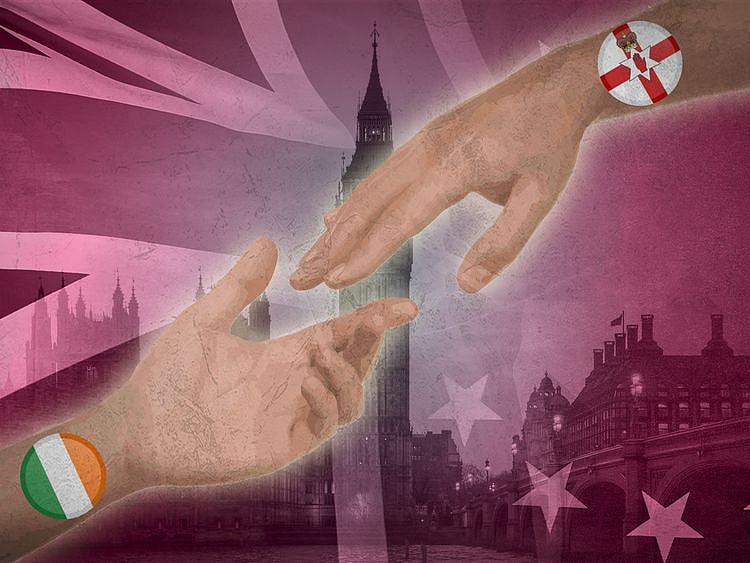Building a lasting peace in Ireland
It has been 25 years since the Good Friday Agreement. Peace can’t be taken for granted

In Dublin recently, as I walked the bustling city centre, there was a small gathering outside the General Post Office.
The GPO, on the main thoroughfare O’Connell Street, is a historic building, and back in April 1916, was the headquarters for Irish Republican Army fighters who failed in their attempt to declare an Irish Republic and end some eight centuries of British rule in Ireland.
As an aside, my grandfather was one of those rebels who surrendered when it was obvious their fight had failed, and he spent from then until Christmas Day 1918 in a prison camp in Wales.
While that 1916 rebellion did fail, the rebels secured victory five years later in a process that would ultimately divide the island of Ireland into the republic in the southern 26 counties, with the six counties in Northern Ireland remaining in the United Kingdom.
A personal connection
Grandad was jailed again in December 1920 when he was arrested following an ambush on a British Army truck in Dublin, and when the treaty declaring the Irish Republic — or the Irish Free State as it was known back then — on July 11, 1921 he was in a prison cell north of the newly created border.
As with any peace, compromises need to be made, and he was released to return to his civilian life in the new state.
Soon, Northern Ireland will be marking 25 years of the signing of the Good Friday Agreement — the process that set up a unique power-sharing assembly in Belfast and ended more than three decades of political and sectarian violence that claimed some 3,600 lives and injured 36,000 more in the British-ruled province.
But the GFA didn’t necessarily bring immediate peace. It was never intended as a magic and instant solution. Instead, it brought about the conditions where deeply polarised nationalist and loyalist communities could begin to build trust in what is referred to as a “peace process”.
That process has largely worked — violence has ended, the bomb and the bullet were removed from Irish politics, and political parties from all sides could begin to create a new society where all might live together in harmony.
GFA under threat
And as part of that GFA, prisoners on both sides of the violent divide were freed. Today, GFA is under threat — in part that those who helped shape it are long gone from the political scene.
Then US President Bill Clinton sent a peace envoy, the UK Prime Minister John Major and Irish Taoiseach Bertie Ahern worked endlessly to seal the deal, so too the late Unionist Leader David Trimble and the late SDLP leader John Hume, while Sinn Fein and loyalist parties convinced paramilitaries to lay down and decommission their weapons. Trimble and Hume won the Nobel Peace Prize for their efforts.
It was a major international breakthrough, one that was only possible by all sides being willing to compromise and reach a deal to build a peace.
Indeed, the GFA shows that peace can be achieved with leaders who have the courage to lead and have a vision and belief in better times.
It’s a lesson that could be learnt by those in Israel now, for example. The passing on a generation of political leaders has also meant that a quarter of a century later, peace and stability might be taken for granted, and that there is little risk of a return to the darkest days of that violence.
Restoring confidence
But peace and this peace process is fragile, and the divisions brought by Brexit have done little to build or restore confidence between the divided communities.
Because of the “over ready” Brexit deal quickly signed by Boris Johnson with the European Union, Northern Ireland remains in the customs zone that covers the 27 states of the common market, with the rest of the UK — England, Scotland and Wales — outside the bloc.
Because of Brexit too, the power-sharing Northern Ireland Assembly isn’t functioning. The largest loyalist party — the Democratic Unionists — refuse to share power until the protocol is resolved to their satisfaction.
While there are reports that the UK government under Rishi Sunak and the EU have broadly reached a deal to make the protocol work, the DUP aren’t convinced.
The deal would see green and red channels at Northern Ireland ports, much as air passengers have when they land at an airport. Green for nothing to declare, red for goods that need to be inspected or would be going on to the Republic of Ireland in the south.
If today’s generation of political leaders want to respect the GFA and the peace process it started, they ought move mountains to fully resolve the protocol mess one way or another. That’s the first step in making the power-sharing government work — and that would enable reforms to Northern Ireland’s economy to improve the lives of all there.
Sign up for the Daily Briefing
Get the latest news and updates straight to your inbox
Network Links
GN StoreDownload our app
© Al Nisr Publishing LLC 2025. All rights reserved.